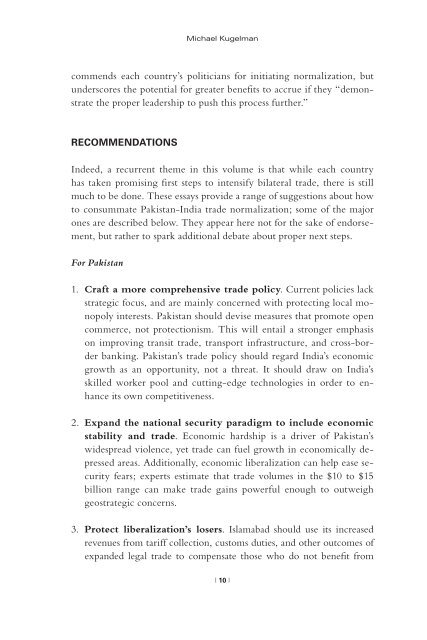You also want an ePaper? Increase the reach of your titles
YUMPU automatically turns print PDFs into web optimized ePapers that Google loves.
Michael Kugelman<br />
commends each country’s politicians for initiating normalization, but<br />
underscores the potential for greater benefits to accrue if they “demonstrate<br />
the proper leadership to push this process further.”<br />
reCoMMendaTions<br />
Indeed, a recurrent theme in this volume is that while each country<br />
has taken promising first steps to intensify bilateral trade, there is still<br />
much to be done. These essays provide a range of suggestions about how<br />
to consummate <strong>Pakistan</strong>-<strong>India</strong> trade normalization; some of the major<br />
ones are described below. They appear here not for the sake of endorsement,<br />
but rather to spark additional debate about proper next steps.<br />
For <strong>Pakistan</strong><br />
1. Craft a more comprehensive trade policy. Current policies lack<br />
strategic focus, and are mainly concerned with protecting local monopoly<br />
interests. <strong>Pakistan</strong> should devise measures that promote open<br />
commerce, not protectionism. This will entail a stronger emphasis<br />
on improving transit trade, transport infrastructure, and cross-border<br />
banking. <strong>Pakistan</strong>’s trade policy should regard <strong>India</strong>’s economic<br />
growth as an opportunity, not a threat. It should draw on <strong>India</strong>’s<br />
skilled worker pool and cutting-edge technologies in order to enhance<br />
its own competitiveness.<br />
2. Expand the national security paradigm to include economic<br />
stability and trade. Economic hardship is a driver of <strong>Pakistan</strong>’s<br />
widespread violence, yet trade can fuel growth in economically depressed<br />
areas. Additionally, economic liberalization can help ease security<br />
fears; experts estimate that trade volumes in the $10 to $15<br />
billion range can make trade gains powerful enough to outweigh<br />
geostrategic concerns.<br />
3. Protect liberalization’s losers. Islamabad should use its increased<br />
revenues from tariff collection, customs duties, and other outcomes of<br />
expanded legal trade to compensate those who do not benefit from<br />
| 10 |


